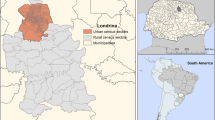Abstract
In ecological studies, researchers often try to convey the analysis results to individual level based on aggregate data. In order to do this correctly, the possibility of ecological bias should be studied and addressed. One of the key ideas used to address the ecological bias issue is to derive the ecological model from the individual model and to check whether the parameter of interest in the individual model is identifiable in the ecological model. However, the procedure depends on unverifiable assumptions, and we recommend checking how sensitive the results are to these unverifiable assumptions. We analyzed the tuberculosis data that was collected in Seoul in 2005 using a spatial ecological regression model for the aggregate count data with spatial correlation, and found that the deprivation index is likely to have a small positive effect on the occurrence risk of tuberculosis in individual level in Seoul. We considered this finding in various aspects by performing in depth sensitivity analyses. In particular, our findings are shown to be robust to the distribution assumptions for the individual exposure and missing binary covariate across various scenarios.








Similar content being viewed by others
References
Besag J (1974) Spatial interaction and the statistical analysis of lattice systems (with discussion). J R Stat Soc Ser B 36:192–236
Besag J, Higdon D (1999) Bayesian analysis of agricultural field experiments (with discussion). J R Stat Soc Ser B 61:691–746
Besag J, Kooperberg C (1995) On conditional and intrinsic autogressions. Biometrika 82:733–746
Besag J, York J, Mollié A (1991) Bayesian image restoration, with two applications in spatial statistics. Ann Inst Stat Math 43:1–20
Deguen S et al (2010) A small-area ecologic study of myocardial infarction, neighborhood deprivation, and sex—a Bayesian modeling approach. Epidemiology 21:459–466
Diggle PJ, Elliott P (1995) Statistical issues in the analysis of disease risk near point sources using individual or spatially aggregated data. J Epidemiol Community Health 49:S20–27
French C, Kruijshaar M, Jones J, Abubakar I (2009) The influence of socio-economic deprivation on tuberculosis treatment delays in England, 2000–2005. Epidemiol Infect 137:591–596
Greenland S (1992) Divergent biases in ecologic and individual-level studies. Stat Med 11:1209–1223
Greenland S (2001) Ecologic versus individual-level sources of bias in ecologic estimates of contextual health effects. Int J Epidemiol 30:1343–1350
Greenland S (2002) A review of multilevel theory for ecologic analyses. Stat Med 21:389–395
Greenland S, Morgenstern H (1987) Ecological bias, confounding, and effect modificiation. Int J Epidemiol 18:269–274
Haneuse S, Wakefield J (2004) Ecological inference incorporating spatial dependence. In: King G, Rosen O, Tanner MA (eds) Ecological inference: new methodological strategies. Cambridge University Press, New York, pp 266–301
Jackson C, Best N, Richardson S (2005) Improving ecological inference using individual-level data. Stat Med 25:2136–2159
Jee S, Golub J, Jo J, Park I, Ohrr H, Samet J (2009) Smoking and risk of tuberculosis incidence, mortality, and recurrence in south Korean men and women. Am J Epidemiol 170:1478–1485
Kim J, Yim J (2015) Achievements in and challenges of tuberculosis control in South Korea. Emerg Infect Dis 21:1913–1920
Kim I, Bahk J, Yoon T, Yun S, Khang Y (2017) Income difference in smoking prevalences in 245 districts of South Korea: patterns by area deprivation and urbanity, 2008–2014. J Prevent Med Public Health 50:100–126
Korea Centers for Disease Control and Prevention (2008) The main results. Community Health Survey website. https://chs.cdc.go.kr/chs/index.do. Accessed 8 June 2015
Le Cam L (1960) An approximation theorem for the Poisson binomial distribution. Pac J Math 10:1181–1197
Lopez De Fede A, Stewart J, Harris M, Mayfield-Smith K (2008) Tuberculosis in socio-economically deprived neighborhoods: missed opportunities for prevention. Int J Tuberc Lung Dis 12:1425–1430
McLennan D, Barnes H, Noble M et al (2011) The English indices of deprivation 2010. Department for Communities and Local Government, London
Richardson S, Stucker I, Hemon D (1987) Comparison of relative risks obtained in ecological and individual studies: some methodological considerations. Int J Epidemiol 16:111–120
Rue H, Held L (2005) Gaussian Markov random fields:theory and applications. Chapman and Hall/CRC, Boca Raton
Salway R, Wakefiled J (2005) Sources of bias in ecological studies of non-rare events. Environ Ecol Stat 12:321–347
Spiegelhalter D, Best NG, Carlin BP, van der Linde A (2002) Bayesian measures of model complexity and fit (with discussion). J R Statist Soc B 164:583–639
Steele JM (1994) Le Cam’s inequality and Poisson approximations. Am Math Mon 101:48–54
Thomas A, Best N et al (2004) GeoBugs user manual. Medical Research Council Biostatistics Unit. http://www.mrc-bsu.cam.ac.uk/software/bugs/thebugs-project-geobugs/. Accessed 8 June 2015
Townsend P (1987) Deprivation. J Soc Policy 16:125–146
Wakefield J (2003) Sensitivity analysis for ecological regression. Biometrics 59:9–17
Wakefield J (2007) Disease mapping and spatial regression with count data. Biostatistics 8:158–183
Wakefield J, Salway R (2001) A statistical framework for ecological and aggregate studies. J R Stat Soc A 164:119–137
World Health Organization (2014) Global tuberculosis report 2014. WHO website. http://www.who.int/tb/country/en/. Accessed 8 June 2015
Acknowledgements
This research was supported by the Basic Science Research Program through the National Research Foundation of Korea (NRF) funded by the Ministry of Education (NRF-2016R1D1A1B03936100) and the Bio-Synergy Research Project (NRF-2017M3A9C4065964) of the Ministry of Science, ICT and Future Planning through the National Research Foundation.
Author information
Authors and Affiliations
Corresponding author
Additional information
Handling Editor: Pierre Dutilleul.
Appendix
Appendix
In Sect. 7, we assume that \(x_{ij}|z_{ij} \sim N(x_{i}+\psi z_{ij},s^2_{i})\). Note that
where \(m_{i}\) denotes the smoking rate in ith dong. The difference of mean deprivation indices between two different dongs (i and \(i'\)) becomes
Therefore, we have
Take two dongs where \(m_{i}>m_{i'}\). If we assume that \(\psi >0\) and \(x_{i}\) monotonically increases with \(m_{i}\), then
Rights and permissions
About this article
Cite this article
Song, E., Kim, S., Hwang, S. et al. Sensitivity analysis on the ecological bias for Seoul tuberculosis data. Environ Ecol Stat 25, 341–362 (2018). https://doi.org/10.1007/s10651-018-0408-4
Received:
Revised:
Published:
Issue Date:
DOI: https://doi.org/10.1007/s10651-018-0408-4




